July 22, 2020
Has life existed beyond Earth? Purdue professor going to great lengths to find out.
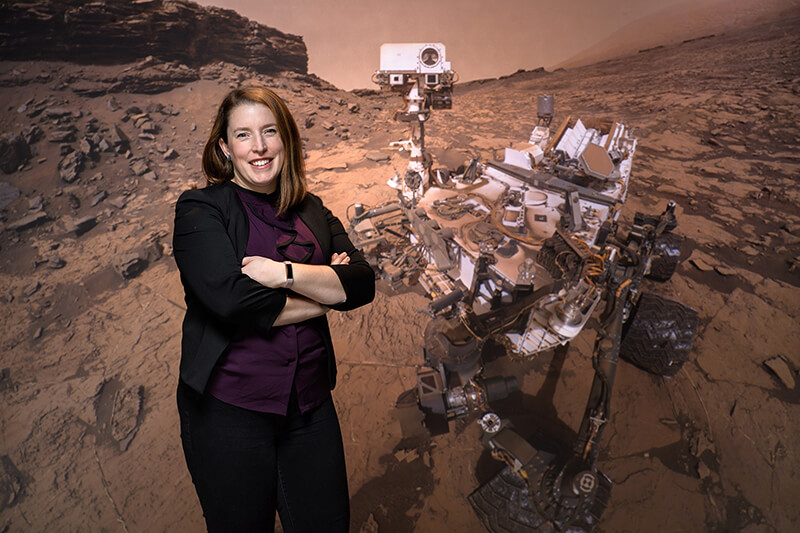
Briony Horgan, associate professor of earth, atmospheric, and planetary sciences at Purdue University, is working to determine whether we are alone in the universe, or if life once existed on other planets such as Mars. (Purdue University image/John Underwood)
Purdue scientist plays a critical role in 2020 NASA Mars rover mission
WEST LAFAYETTE, Ind. — When the NASA Mars rover Perseverance launches in the next few weeks, it will travel to Jezero Crater, which preserves evidence of a time when rivers flowed on Mars.
The mission will take the next leap in space science by searching for signs of past life on the red planet. Not the Martians of comic-book science fiction, but instead ancient microbes may have lived in Mars' rivers, lakes and swamps billions of years ago.
This scientifically important landing site within Jezero Crater was selected by NASA following a presentation by Briony Horgan, Purdue University associate professor of planetary science, who is a member of the Perseverance science team. Horgan led a study of the mineralogy of the site, which produced one of the major results that contributed to its selection. She was also on the team that designed the camera that will be the scientific eyes for Perseverance.
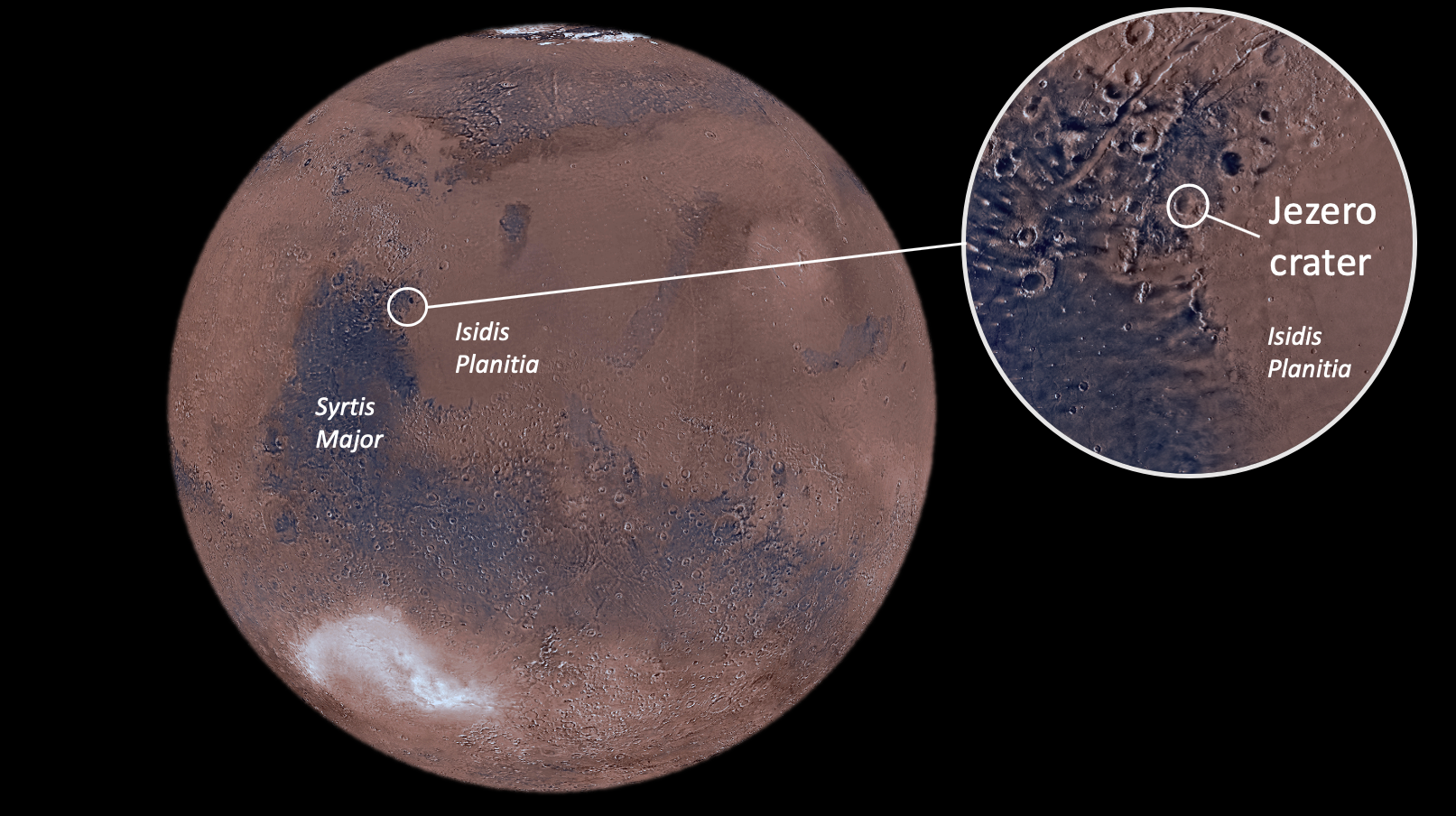
The Mars rover Perseverance will arrive at the red planet in February 2021. Purdue planetary scientist Briony Horgan was part of the science team that selected the landing site in Jezero Crater, just north of the planet's equator. (Image courtesy NASA Ames/USGS/JPL/Corrine Rojas. This work is licensed under a Creative Commons Attribution-NonCommercial 3.0 Unported License)
The Mission
The primary mission of the Perseverance rover is to look for signs of past life on Mars. Horgan and her colleagues approach the work like forensic detectives, looking for clues and literally microscopic bits of evidence.
If there had been life on the Red Planet, it would have left behind chemical clues that the scientists hope can still be found in the rock.
"The goal of this mission is to look for signs of ancient life on Mars and then also collect samples for future return to Earth, Horgan says. "It's possibly the only chance we'll ever have to get to do both of those things, especially the sample return. It's really hard to do, and it's expensive.
"We know we might only have this one chance to do this, and it was tough to select the site. If we had to choose just one spot on Earth to gather all the data about the entire history of the planet — well, where would you go? But we think Jezero Crater is the best location to search for evidence that life existed on Mars, if it ever did. And what we find will help us learn more about whether or not we are alone in the universe."
Perseverance will spend its time taking photographs, video, pulverizing rock by shooting lasers (so that scientists can determine the chemical composition), using microscopes to search for organic molecules, drilling, analyzing and doing a variety of science chores. This will produce enormous volumes of data that will take the scientists years to analyze.
NASA plans to send a return mission in the next decade to retrieve the samples, which will be stored in Perseverance.
"Bringing samples back from Mars would be amazing," Horgan says. "It would not only be a feat of engineering to retrieve the samples and return them, but it would be the first time we would have samples brought back to Earth from another planet. That would be quite historic."
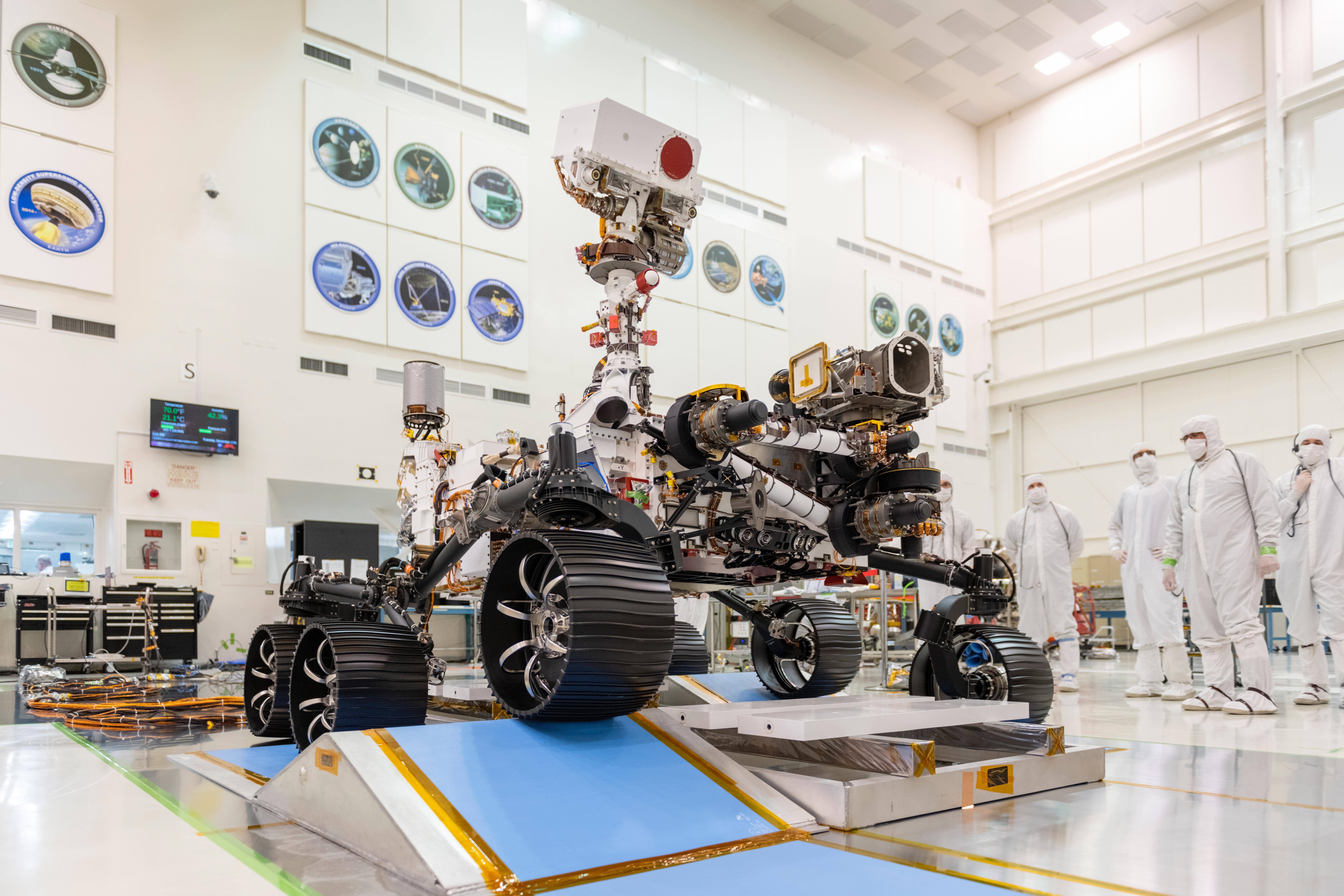
The Mars rover Perseverance is an SUV-sized feat of engineering that is both an advanced spacecraft and a mobile scientific laboratory. Purdue planetary scientist Briony Horgan was part of a team that designed some of the scientific instruments, including the stereo Mastcam-Z camera. (Courtesy NASA/JPL-Caltech)
The Rover
The first Mars rover, the diminutive, microwave-sized Sojourner, landed on the Fourth of July in 1997. The American public found the rover fascinating —possibly even adorable — and Hot Wheels soon began producing a popular toy model of the craft.
The car-sized Perseverance, NASA's fifth Mars rover, more than makes up in scientific capability for what it lacks in toy-like cuteness. It is the largest, heaviest rover, and contains a futuristic suite of technologies. It has lasers to vaporize rock (so that scientists can view the light wavelengths produced to understand the chemical composition), autonomous driving capabilities so that it can move above the speed of a crawl to the next research site, drills to collect pencil-sized samples, an internal robotic system to collect and store the samples, a test system for creating breathable oxygen from Mars’ atmosphere. And, as the late Steve Jobs might say, one more thing: a helicopter-like drone, which will attempt to fly in an atmosphere that is 100 times thinner than that of Earth.
But for the science team, the attention will be on a 7-foot robotic arm on the exterior of the rover; at the end of the arm is a lawn-mower-sized cluster of instruments.
"This robotic arm is really the workhorse," Horgan says. "We can place it with millimeter precision, which is incredible. And out on the arm are these amazing microscopes that we can use to map minerals and organic materials at very fine scale."
Atop the mast of the rover is a special dual-lens camera, Mastcam-Z, that Horgan has a special affinity to because she is part of the team that designed it and will help to operate the camera on Mars.
The camera has a zoom capability strong enough that it could be used to view a house fly at the far end of a soccer field. The camera can record images in color, in 3D, and in video. It is precise enough that the scientists can use it for compositional analysis of the surrounding terrain.
"We can actually do some really simple spectroscopy looking at the wavelength dependence of sunlight reflected off of rocks to help identify their mineral fingerprints," Horgan says.

The landing site for the Mars rover Perseverance is shown with the oval circle on the edge of Jezero Crater. The landing site is at the edge of what is thought to be an ancient river delta. In this image, green is higher elevation and blue is lower elevation. Purdue University planetary scientist Briony Horgan was a member of the team of scientists that identified and selected the landing site. (Courtesy NASA/JPL-Caltech)
The Landing Site
Perseverance is expected to land in a specific location north of the Martian equator in a 28-mile-wide crater named Jezero, a site selected by a scientific team. The site is attractive because it's thought that the crater once contained a lake about the size of Lake Tahoe.
"If you look at the site, you can see evidence of a big river channel leading into the crater, creating a delta where it entered a lake, and a second big river channel leading out of the crater," Horgan says. "This landing site is exciting because we have really clear evidence that this ancient lake existed, that it had persistent liquid water for a long enough time to create this ancient delta, and that there was enough water flow to overflow out the other side to create the outflow channel. This suggests that the lake was a long-lived and stable environment that could have been inhabited by ancient microbial life."
The rover will attempt to land at the edge of the crater near the delta so it can explore both landscapes. The target site is known as the "landing ellipse."
"The landing ellipse for Mars 2020 is about 7-by-9 kilometers [4.4 by 5.6 miles], which is actually very small. If you think back to even 17 years ago, when we sent two rovers, Spirit and Opportunity, to Mars, their landing ellipse was about 100 kilometers long for each of them. So, we've gotten really good at pinpointing our landing," she says.
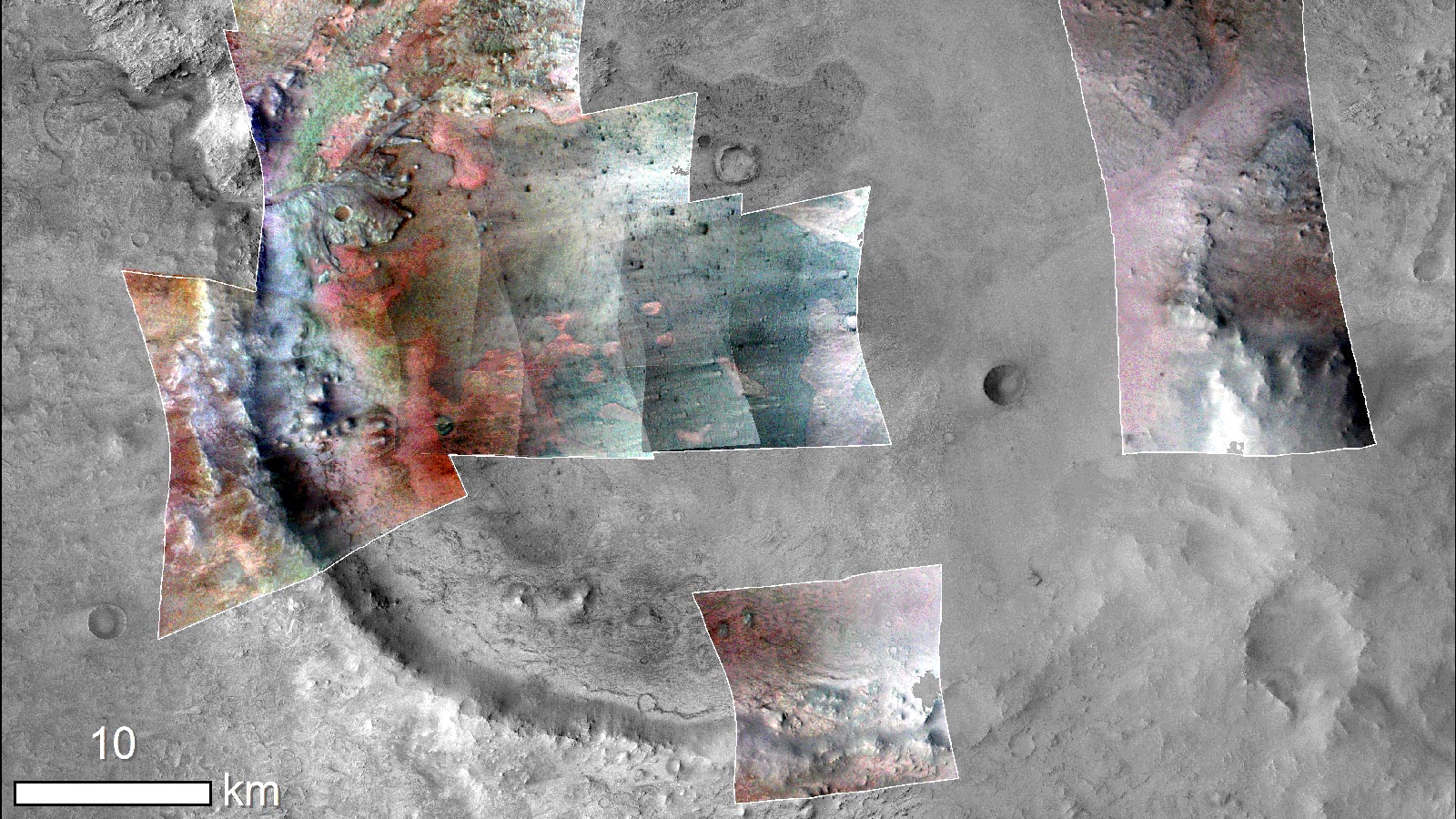
Scientists looking for signs of past life on Mars are focusing on an area rich in minerals called carbonates (the green color in this image), which on Earth are known for preserving fossilized life. (Courtesy NASA/JPL-Caltech/MSSS/JHU-APL/Purdue/USGS)
The Science
For this Mars mission, the scientists are looking for signs of past life by looking for biosignatures, which are clues that life once existed there. Biosignatures can vary from something as small as specific isotopes or chemicals produced by living things, such as cholesterol, to something much larger, such as microscopic fossils.
"A dinosaur bone is an example of a biosignature that we find in ancient rocks on Earth," Horgan says. "I would love to find evidence that dinosaurs once roamed Mars, but instead we are going to be looking for biosignatures of bacteria-sized microbes."
This is where the stored samples on Perseverance come into play. The plan is for a separate mission, to be done in partnership with the European Space Agency, to return to Mars and retrieve the samples.
"Once the samples are back on Earth, we can use much more powerful tools, such as scanning electron microscopes, to confirm whether these biosignatures were created by microbes," she says.
"As part of our work to evaluate Jezero during site selection, I led a team to study the mineralogy of the lake deposits. And we came up with some really cool results.”
Horgan and her colleagues discovered evidence of carbonates around the edge of the former lake, in what Horgan describes as a "bathtub ring." The ring of carbonates occurs right where ancient shorelines and beaches for the lake are predicted, so the team proposed that they formed on the edge of the lake.
On Earth, carbonates are known for two things. One, they indicate that the site where they are found once contained water. Second, they form sediments that are usually rich in fossils.
"This is really exciting because that's exactly the kind of place you would go to look for microbial biosignatures from a lake on Earth. When those minerals precipitate out of water, they can trap anything, including microbes and organic materials," she says. "So, we've been doing a lot of work on the team to try to plan how we're going to explore this site."

The launch of a Mars rover brings exhilaration and anxiety spaced seven months apart, says Purdue University planetary scientist Briony Horgan, who is part of the science team for the 2020 rover mission — excitement at the launch and concern as the rover slams into the thin atmosphere of the planet. (Courtesy NASA/JPL-Caltech)
The Launch
2020 will be the summer of Mars launches, with rockets blasting off from the United States, China, and a United Arab Emirates rocket, which launched from Japan.
The rover will launch on top of a two-stage Atlas rocket sometime during the launch window, which extends from July 30 to Aug. 15. It is expected to arrive at Mars in February 2021.
Horgan had planned to attend the launch of Perseverance, but because of the dramatically increasing number of cases of COVID-19, the launch viewing has been canceled, so she will watch it from West Lafayette.
"Several years ago, I was able to watch the Mars Science Laboratory launch. It was one of the best moments of my life because it's the result of so many years of scientific and engineering effort, and the launch is just the best feeling. It's incredible," she says.
Horgan contrasts the thrill of the launch with the anxiety of the landing.
"The landing is always so stressful because you're basically sending your prized rover, which you've spent so many hours thinking about and working on, in a giant fireball to slam into the surface of a planet," she says. "The fireball forms because the rover enters Mars’ atmosphere at 13,000 mph, generating a huge envelope of plasma around the rover. You can't get radio signals through the plasma fireball. It takes seven minutes for the rover to go down to the surface from when it enters the atmosphere.
"But it also takes seven minutes for the radio signal to get back to Earth. So, by the time we receive the signal that the rover has hit the atmosphere, either it is actually on the surface of the planet doing well, or it has crashed into the surface. You just don't know, so we'll be anxiously waiting to get that first signal back from the rover to know that it landed safely. That's why we call it the seven minutes of terror."
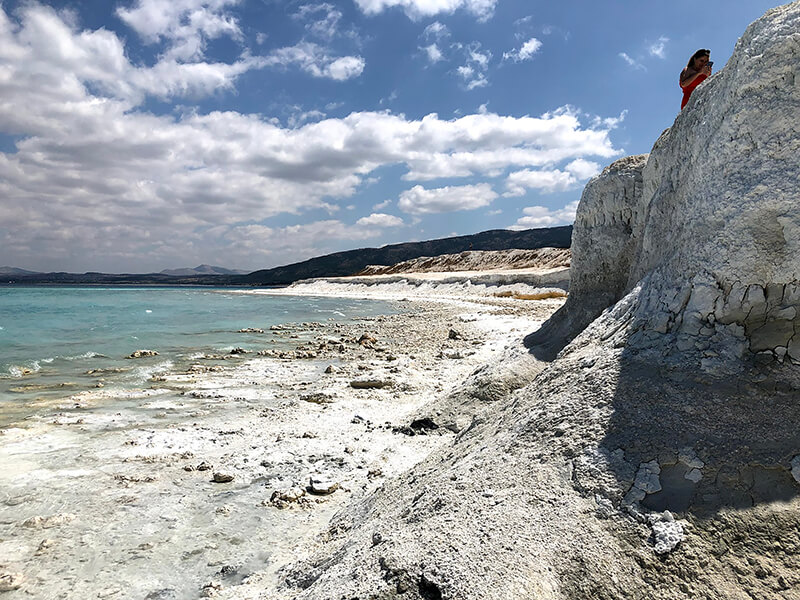
Sometimes to study Mars researchers must first study similar sites on Earth that may resemble terrain on Mars, which scientists call an analog environment. For example, eight hours from Istanbul, Turkey, is a deep lake, Lake Salda, which has carbonates and fossilized microbes in the form of stromatolites, exactly of the type that the scientists hope to find on Mars' Jezero Crater. (Purdue University image/Briony Horgan) Download image
The Future
"One of the best things about a Mars mission like this is that it's a great opportunity for students to get involved. I have a couple of graduate students who are helping with landing site analysis on the team and will help operate the rover on Mars," Horgan says. "We're planning to have undergrads back at Purdue also working on rover data processing and analysis.
Sometimes the work with students includes field work at sites on Earth that may resemble terrain on Mars, which scientists call an analog environment. For example, in September 2019 Horgan, Ph.D. student Bradley Garczynski, and a research team traveled eight hours from Istanbul, Turkey, to a deep lake, Lake Salda. The lake has carbonates and fossilized microbes in the form of stromatolites, exactly of the type that the Mars scientists hope to find on Jezero Crater.
"This is how we train the future of planetary science. We bring them onto the mission, and years from now they can become mission leaders," Horgan says.
About Purdue University
Purdue University is a top public research institution developing practical solutions to today’s toughest challenges. Ranked the No. 6 Most Innovative University in the United States by U.S. News & World Report, Purdue delivers world-changing research and out-of-this-world discovery. Committed to hands-on and online, real-world learning, Purdue offers a transformative education to all. Committed to affordability and accessibility, Purdue has frozen tuition and most fees at 2012-13 levels, enabling more students than ever to graduate debt-free. See how Purdue never stops in the persistent pursuit of the next giant leap at https://purdue.edu/.
Writer, Media contact: Steve Tally, steve@purdue.edu, @sciencewriter
Source: Briony Horgan, briony@purdue.edu, @ironywithab
Note to Journalists: Photos are available on a Google Drive folder. NASA offers b-roll, animation of the rover on the surface of Mars, and video of the testing of the rover. A press kit is also available.
Journalists visiting campus: Journalists should follow Protect Purdue protocols and the following guidelines:
- Campus is open, but the number of people in spaces may be limited. We will be as accommodating as possible, but you may be asked to step out or report from another location.
- To enable access, particularly to campus buildings, we recommend you contact the Purdue News Service media contact listed on the release to let them know the nature of the visit and where you will be visiting. A News Service representative can facilitate safe access and may escort you on campus.
- Wear face masks inside any campus building. Wear face masks outdoors when social distancing of at least six feet is not possible.
Note to Journalists: Photos are available on a Google Drive folder. NASA offers b-roll, animation of the rover on the surface of Mars, and video of the testing of the rover. A press kit is also available. Journalists visiting campus should follow visitor health guidelines.

